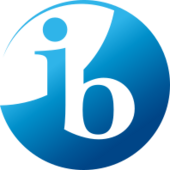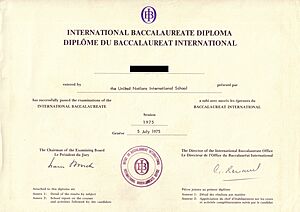International Baccalaureate facts for kids
 |
|
| Formation | 25 October 1968 |
|---|---|
| Headquarters | Geneva, Switzerland |
The International Baccalaureate (IB) is a special education group. It is a non-profit foundation. The IB started in 1968 in Geneva, Switzerland. It helps schools around the world.
The IB offers four main learning programmes. These programmes are for students of different ages. They help students learn in a global way. Schools must be approved by the IB to teach these programmes. In 2007, the IB changed its name and logo. Now, "IB" can mean the organization itself. It can also mean any of its four programmes. Or it can mean the diploma students earn.
What is the IB?
The International Baccalaureate helps students learn. It focuses on understanding the world. It also helps students think for themselves. The IB wants students to be curious. It encourages them to be caring and knowledgeable.
IB Programmes for Students
The IB has four main programmes:
- IB Primary Years Programme (PYP): This is for children aged 3 to 12. It helps young learners explore and discover.
- IB Middle Years Programme (MYP): This programme is for students aged 12 to 16. It helps them connect school subjects to the real world.
- IB Diploma Programme (DP): This is for students aged 16 to 19. It is a challenging programme. It helps prepare students for university.
- IB Career-related Programme (CP): This is also for students aged 16 to 19. It combines academic learning with career-related studies.
History of the IB
How the IB Started
The idea for the IB began a long time ago. In 1948, a person named Marie-Thérèse Maurette wrote a book. It was about teaching for peace. She wanted education to help people understand each other. This idea became a core part of the IB.
In the 1960s, teachers at the International School of Geneva worked on this idea. They wanted a global education system. They created a group called ISES. This group later became the International Baccalaureate.
First Programme: The Diploma
The IB officially started in 1968 in Geneva, Switzerland. Its first programme was the IB Diploma Programme. This programme was for students aged 16 to 19. It aimed to help students get into universities anywhere. This was especially helpful for families who moved often. The programme offered standard courses and tests.
Over time, the IB grew. New offices opened in different parts of the world. These included North America in 1975. Offices for Africa, Europe, and the Middle East opened in 1986. An office for Asia Pacific also opened around that time.
Other Programmes Developed
The IB Middle Years Programme (MYP) started in 1994. Soon, schools in many countries offered it. The IB Primary Years Programme (PYP) began in 1996. It was first tested in 30 schools. By 1997, the first PYP school was approved. The IB Career-related Programme started in 2012.
Leaders of the IB
Many people have led the IB over the years. Alec Peterson was the first leader from 1968 to 1977. Other leaders followed him. Since May 2021, Olli-Pekka Heinonen has been the Director General. He helps guide the IB's work.
How the IB is Organized
The IB has its main office in Geneva, Switzerland. This office handles legal matters. It also manages the overall operations. Another important office is in Cardiff, Wales. This office handles exams. It creates and marks tests for students.
The IB also has three other main centres around the world:
- IB Global Centre, Singapore: This centre manages schools in Asia-Pacific.
- IB Global Centre, The Hague: This centre manages schools in Africa, Europe, and the Middle East.
- IB Global Centre, Washington D.C.: This centre manages schools in North and South America.
There are also smaller groups called "sub-regional associations." These groups help IB schools and teachers. They offer support and a place to share ideas. There are 56 such groups worldwide.
The IB works to make its programmes available to more students. This includes students who might not have many opportunities. They have projects in countries like Ecuador, Poland, and South Africa. The United States has the most IB programmes.
The IB also works with governments. It works with other non-profit groups. It has a special status with UNESCO. This helps the IB share its ideas globally.
How the IB is Managed
The IB is managed by a Board of Governors. This Board makes important decisions. It sets the direction for the IB. It also makes sure the exams are fair. The Board has between 15 and 25 members. These members come from different backgrounds. This helps make sure many voices are heard.
The Board also chooses the Director General. They oversee the IB's money. They make sure the IB follows its mission. There are also advisory groups. These groups include the Heads Council. They give advice to the Board.
See also
- Cambridge International Education
- European Baccalaureate
- List of International Baccalaureate people
- Schools offering International Baccalaureate
- Advanced Placement


